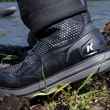The areas below waterfalls, both big and small, can be great places to seek out big trout. This should come as no surprise. Typically referred to as plunge pools, the water that sweeps over falls and into these pools continuously delivers all manner of food to fish waiting below. In areas where the plunging water is pinched or otherwise funneled by the structure of the stream, falls not only deliver food that has swept down from above but also produce a concentrated, high density stream of that food. The turbulent nature of water on the surface of a plunge pool serves to obscure and conceal everything below, providing excellent cover from predators. And despite the turbulent, often violent currents at the surface of these pools, the deep, sometime boulder-filled recesses below offer respite from strong currents.
Don't Pass Them By
Bigger trout push smaller trout out of prime lies. That's the way it goes. So, the fact that these pools offer up a bounty all of a trout's most important needs: cover, food and protection from currents, makes them prime lies. This, in turn, means that they will commonly hold some of the best trout in the stream. Still, I've seen many a fisherman pass them by or ply them only momentarily, put off by the chaotic nature of the water's flow or unwilling to strap on 14 pieces of split shot in order to get their fly down to the fish hiding below.
The first of those two common put-offs is sort of a misconception, as water at the bottom of a plunge pool is typically calm and serene compared to the water above. The second, the inability to get a fly down to the bottom of a plunge pool without bowling balls strapped to your leader, is simply a matter of employing the wrong approach.
Plunge pools, for all of the reasons mentioned thus far, should rarely -- if ever -- be passed over.

Accessing the Plunge Pool
The instinct of most, but certainly not all, fly fisherman when fishing plunge pools seems to be to cast into the bubbling, turbulent water below the falls. Often, these casts are delivered right to where the plunging water meets the surface below. As experience will eventually reveal, this is the hardest place at which to attempt to deliver a fly to the water below.
The boiling water below a waterfall is just so because of air, swept below by the diving water, rising back to the surface. The result is a strong upcurrent which virtually any normal nymph rig will be powerless to resist. Casting into this area will result in little more than a fly that never travels far from the surface and one that is obscured by the rough, agitated water.

Thankfully, getting your flies down into prime lies in plunge pools doesn't require elaborate, heavily weighted rigs. Instead of delivering the fly into the tempestuous water at the bottom of the plunge, cast directly into the plunge or just above the plunge. Just as the air that boils back to the surface is swept to the bottom of the pool, so too will your fly be, hopefully right into the field of vision of waiting fish.
One of my favorite plunge pool tactics is to toss a woolly bugger into the plunge, wait for it to get swept below and strip it to life at the bottom of its dive. I like to imagine that the bugger does a fair job of imitating a sculpin, terrestrial, large nymph or other hearty meal that was unsuspectingly swept over the falls and is trying to swim to shelter after getting tossed around by the current. More than a few nice trout have seemed to agree.































Comments
Mike Sepelak replied on Permalink
It's where I'd sit, so it makes perfect sense to me.
PoconoTrout replied on Permalink
I've been fishing them that way (the wrong way) my whole life. It never occurred to me until now how stupid it is. Makes perfect sense to ride the water down. Wonder why it seemed sensible to toss it into the whitewater. Pfft.
Thanks for the wakeup.
Chad Shmukler replied on Permalink
For a long time I fished them both ways, also failing to notice that I was getting nowhere everytime I was casting onto the surface of the pool. Eventually it clicked, but I wasted a lot of time before it did.
Steve K replied on Permalink
Wow, this makes a lot of sense. As a newbie, I have to ask: with all that turbulence pushing the fly around until it reaches the calmer water near the bottom, how do you know when to set the hook? Isn't the indicator getting pulled down into the plunge too?
Chad Shmukler replied on Permalink
Absolutely, though the indicator will pop back up in relative short order (along with the air bubbles) as your rig travels back downstream towards you. Once that happens, you should be able to start judging whether a take is occurring, although admittedly it'll be a bit more difficult than in calmer water.
The fact that -- as you note -- your indicator is typically dragged down with your flies when it first enters the plunge pool is particularly why I often like to strip or otherwise stay tight to the rig at during those first few seconds in the pool. By doing so, any take will be felt, rather than needing to be seen.
Oh, and in order to make sure your rising indicator (especially if you're using a trapped air indicator like the thingamabobber) isn't pulling your flies out of the strike zone in the bottom of the pool, be sure to try to judge the depth of the pool and adjust your strike indicator accordingly.
Aileen Lane replied on Permalink
One of my favorite spots to fish...except I do like to toss my big dry fly right where the water is calm between turbulent waters. Have had huge browns stick their head out to take my fly. Next time, I will have to try and toss one in the plunge.
Fishy Steve replied on Permalink
I learned the virtues of this article once by happenstance on my first fish out in a freestone river. Access to a pool I wanted to fish below the plunge was difficult, so from above the plunge I casted an orange stimulator with pheasant tail nymph dropped behind the stimulator. I was shocked by the immediate hard strike and landed my largest rainbow of that trip. Caught another one soon after moments later.
What I've also learned about fishing these spots is taking care of how to land a fish when you're above the plunge. Do not carelessly dangle the fish out of the water to raise it up to where you are, or bang the fellow up by dragging through rocky plunges. Before you cast into the plunge, figure where you will make your way to land the fish carefully so you can release it.
Jeff replied on Permalink
One issue I often run into with this is that the water typically gets very shallow upstream of - or right at - the plunge. Or the is obscured by rocks or other debris that has gotten hung up at this point. It can often make it difficult to let the flies 'take the ride' without getting snagged. Any tips?
Pages